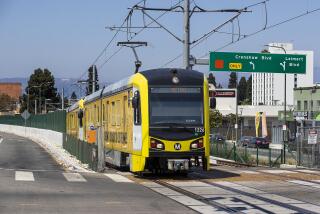Center Tries to Take Byte Out of Drive Time
- Share via
It may sound like more cyber-hype, but urban planner Wally Siembab contends that the Blue Line TeleVillage in Compton is a modern version of an old-fashioned town square.
Siembab worries about the fate of cities.
“Civilization is betting its future on the ability of megalopolises to be livable and sustainable,” he said. “But cities are not working very well.”
Lack of mobility is the central problem in urban areas such as Los Angeles, Siembab said. So the 9-month-old TeleVillage tries to offer a solution with “telemobility.”
The idea is to use the expanding rail network in Los Angeles County to create old-fashioned village centers linked to each other with the latest in telecommunications, providing neighborhoods with access to the Internet and the ability to tap into libraries and universities.
Siembab, a private consultant, city officials and the Metropolitan Transportation Authority hope people will come to the TeleVillage by rail or bus to take advantage of low-cost computers, modems and teleconferencing facilities--and leave their cars at home.
So far, about 530 members pay $10 a year to use the center; the cost is $5 for students and free for senior citizens.
The TeleVillage was built with $559,000 in county ride-share funds and installed by the Drew Economic Development Corp. in the Martin Luther King Transit Center, across from the Blue Line station at 300 N. Willowbrook Ave.
The facility shares the building with a day-care center, food vendors, shops, a small business development center and the Compton Chamber of Commerce.
But sometimes experiments don’t turn out quite the way they are planned.
The project was supposed to make use of excess capacity in a fiber-optic cable installed in the Metrorail tracks, but the engineers didn’t allow for public access. Internet access is achieved through six Pacific Bell ISDN lines.
The TeleVillage also is supposed to be an alternative to fighting traffic, but so far most people using the center drive there in their own vehicles.
I wanted to experience the concept so I took the Green Line from El Segundo and transferred to the Blue Line--an easy fast trip for $1.60.
There were a lot of enthusiastic people using the computer lab on a recent afternoon.
Edmund Sella, a 65-year-old Vista volunteer, was designing a business card. Ken Williams was sending e-mail to foreign universities to get help translating a board game he invented.
Joe Carter, who grew up in Compton, was with two members of his R&B; group “Mind Set Music” working on the Pentium computers, creating a World Wide Web page for their record company. He remembers when Compton, a struggling city these days, had a thriving downtown and he came to shop with his mother and do errands.
Rebuilding a village center for Compton was one of the goals of the TeleVillage project, said Jacki Bacharach, who was a member of the MTA board that approved the facility. The TeleVillage is building liaisons with colleges and libraries and trying to improve access to government services.
Recently, Compton Police Department officers took a course from Cal State Dominguez Hills and the Pasadena Public Library tuned in to author Walter Mosley via teleconferencing for a question-and-answer session.
*
“MetroNet” is next on the agenda. The MTA wants to sell the right to develop a countywide fiber-optic system along more than 300 miles of right of way, reserving space for public access. A request for proposals for the network has been issued and includes the opening of three more TeleVillage centers.
Time will tell how completely the TeleVillage concept will fulfill its potential.
For now, it looks to be working as an economic development tool, helping some enterprising individuals advance career goals.
Public Places writer Jane Spiller welcomes ideas and comments. Contact her c/o NEXT LA or by e-mail at Jane.S[email protected]
More to Read
Sign up for Essential California
The most important California stories and recommendations in your inbox every morning.
You may occasionally receive promotional content from the Los Angeles Times.










